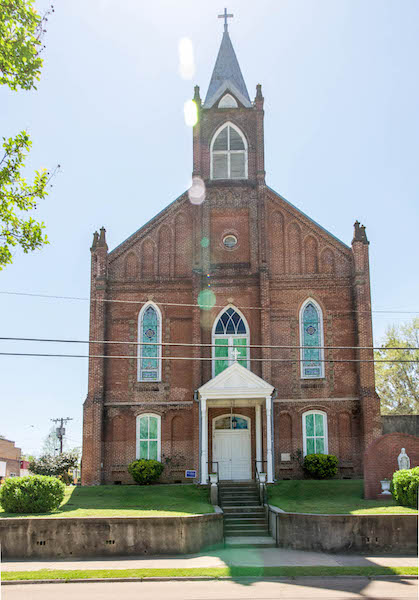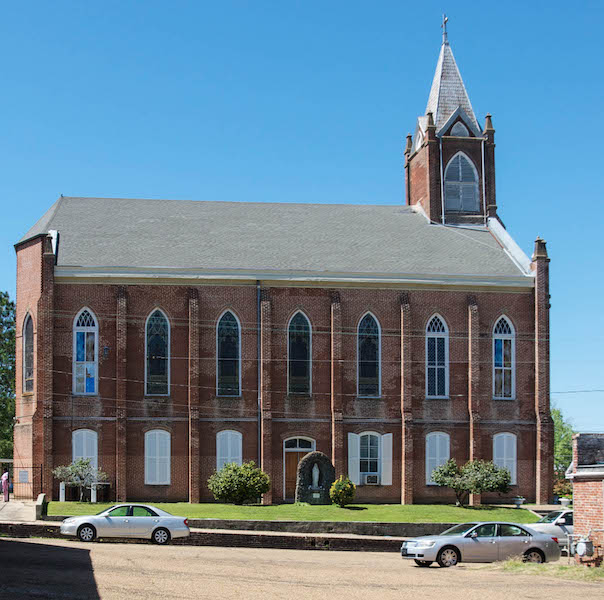
Following up on last week’s Monday Round-up , and after reading the article “New business offers heritage tours to tell other side of Natchez history” and checking out “Race Against Time: Culture and Separation in Natchez Since 1930,” I recalled an accidental tourist stop in Natchez through an African American neighborhood in 2012. I was leaving town and headed down Martin Luther King Boulevard when I caught glimpse of a steeple and the back of a church.
Holy Family was built in 1894 and was the first black congregation of Catholics in Mississippi. The Holy Family Catholic Church Historic District is “arranged around Aldrich, Old D’Evereaux, St. Catherine, Abbott, and Byrne Streets in Natchez.” The Architect/Builder was William K. Ketteringham (Mary Warren Miller, Historic Natchez Foundation, 1995, Nomination form for National Register of Historic Places). According to Miller, St. Catherine Street, which Holy Family faces, was part of the Natchez Trace.
Holy Family Catholic Church architecturally dominates the district due to its siting on a hill, its monumental size, and the elevation of the sanctuary above a fully raised basement. (Miller, 1995)
The church is a Gothic Revival style, featuring Gothic-arched windows, and the basement story retains the original shutter blinds. Richard M. Tristano published in 1998,
a case study to describe a community of Catholic African-Americans in Natchez, Mississippi in the late nineteenth century; to describe who they were and how and why they came to identify themselves as Catholics as well as African-Americans….It is appropriate to use this microhistorical method to recover the story of another lost people, lost both to Catholic and to African-American history, by means of a parish level study, utilizing sacramental and census data. (Holy Family Parish: The Genesis of an African-American Catholic Community in Natchez, Mississippi, The Journal of Negro History, 83(4), 258-283)
Holy Family Parish voted in 1893 to separate from the white-controlled cathedral (St. Mary’s Basilica) and to establish a separate African-American parish. In 1892, 200,000 Catholics of African descent were in the United States, primarily Louisiana and Maryland, although “large colonies” were listed in Natchez and other places (Fort Wayne Sentinel, March 23, 1892).

Holy Family underwent renovations in 2015. You can read the celebration of the renovation and restoration and catch some glimpses of the beautiful interior and stained glass windows in the Natchez Democrat.
Categories: African American History, Churches, Historic Preservation, Natchez

I visited Holy Family a few years ago. I went to see the site of the Natchez Rhythm Club fire and noticed Holy Family and a few interesting older houses a block away from the Rhythm Club fore site.
Well worth seeing for those interested in history and architecture.
LikeLike
Beautiful church! They do have a building and a heritage of which to be proud. I would love to see the stained glass up close, too! Glad you stumbled into this story!
LikeLike
Greatly enjoyed this article! . . . Having grown up on St. Catherine Street in the 1930s-1950s, I was often inside Holy Family church and remember with great fondness the Josephite priests and also the religious women who served there over many, many years. As a very young boy, my Mother would take me to the school auditorium for the annual Christmas pageant performed by the pupils. The Ketteringham family home was only a few yards away and across St. Catherine Street from my home (The Anzalone Grocery & Market) — both slightly east from the famous Brumfield School. . . . Gratefully in the Lord God, J. S. Anzalone
LikeLiked by 1 person